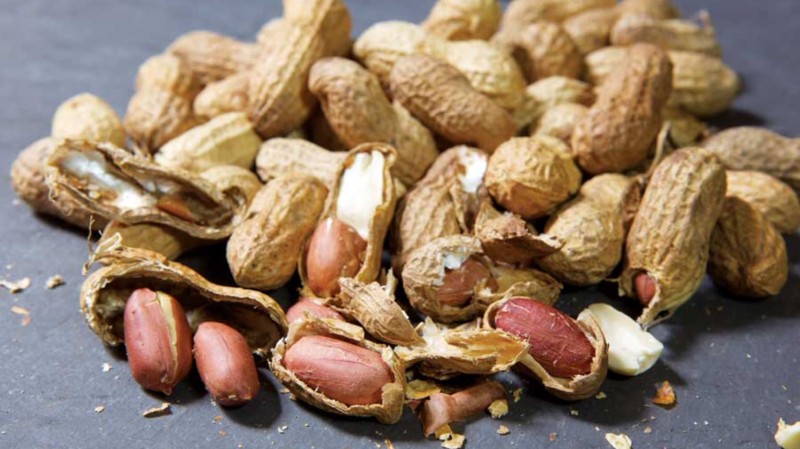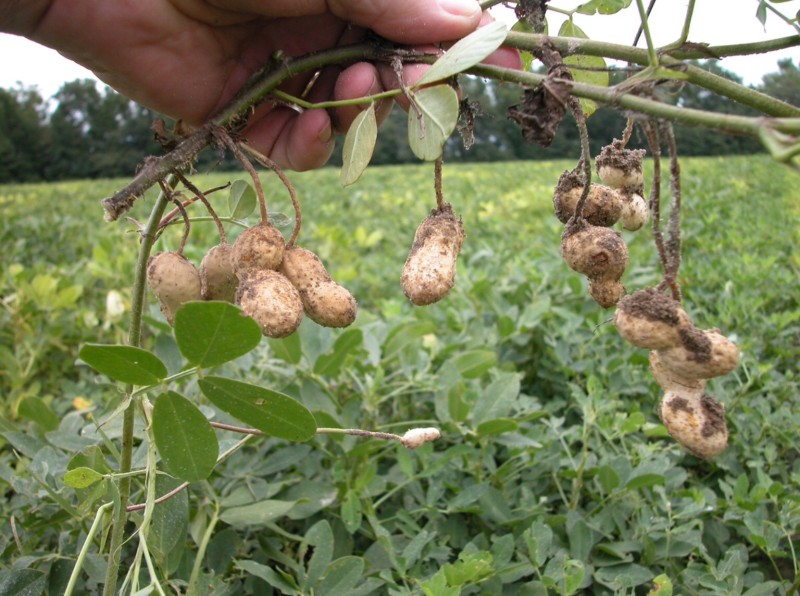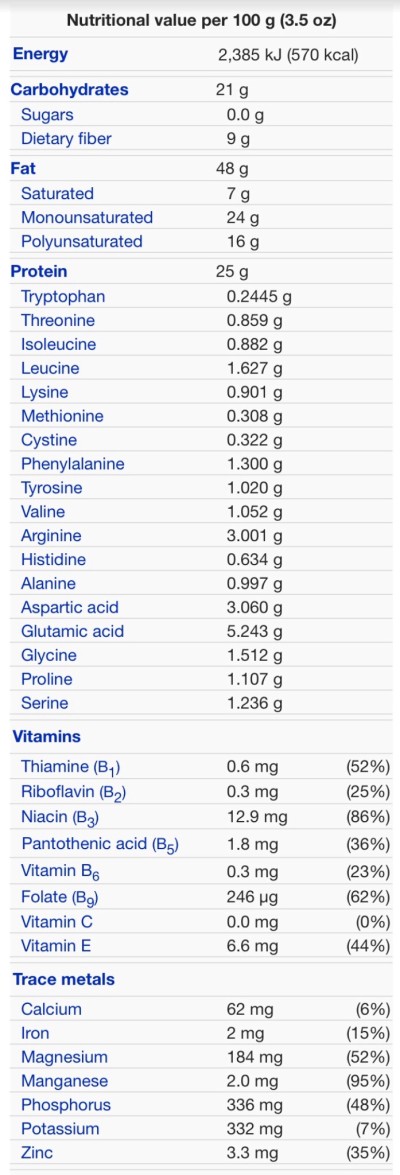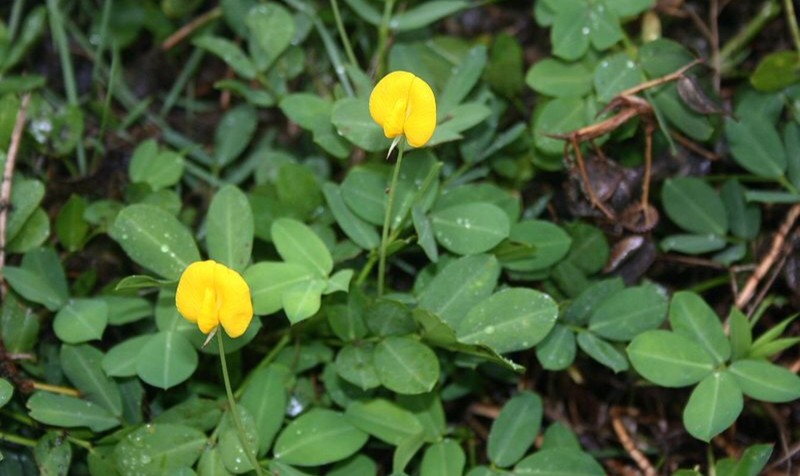Peanuts (Arachis hypogaea) are the legumes of a species of plant in the family Fabaceae, and are one of the most widely eaten plant foods in the world today. Despite the name “peanut”, as just noted peanuts are a legume rather than a true nut — as a “nut” is technically just an indehiscent fruit. That said, in common English peanuts are always referred to as being “nuts”.
Peanuts were first domesticated roughly 8,000 years ago by the American Indian groups living in what’s now Paraguay (along with potatoes, peppers, tomatoes, vanilla, corn, turkeys, a species of cotton, beans, cassava, the rubber plant, chicle/chewing gum, etc), by a rather complex process involving multiple different species.
Peanut plants typically grown to be 1-1.6 feet tall, and are notable for sending their flower stalks (ovaries) underground after pollination — where the legumes (peanuts) then develop. This process is known as geocarpy. These peanut pods typically contain 1-4 peanuts each.
Peanut History & General Information
As mentioned above, the peanut plant was first domesticated roughly 8,000 years ago, in what’s now Paraguay or Bolivia — via a rather involved process, apparently. (Not as ‘involved’ as GMO agriculture though.) The domesticated peanut plant is actually an amphidiploid or allotetraploid — which means that it has two sets of chromosomes, from two different species (in this case thought to be A. duranensis and A. ipaensis).
It’s thought that these either combined in the wild naturally or where intentionally breed together, and in so doing formed the tetraploid species A. monticola — which was then domesticated to something similar to the many varieties seen today (used for different purposes).
The Nahuatl name for peanuts is tlalcacahuatl.
Depictions of domesticated peanuts were fairly common in the art of the various civilizations that rose and fell in that region over the last few thousand years (for related information, see: Olmec Civilization, Specialization, and the Origins Of Agriculture.)
Peanuts apparently spread rapidly throughout the Americas after domestication, with evidence for use far afield from the original site(s) of domestication. This trend continued with the arrival of the Spanish in the region — who then spread peanuts to Europe, Africa, India, China, and elsewhere. Worth noting is that a related plant species from the same family was already being cultivated in West Africa (the Bambara groundnut) at the time of the peanut’s introduction there.
Peanuts remained a common garden crop in North America through the colonial period (this time by the Europeans, not various American Indian groups as before), but was at this time mainly used as animal feed. It wasn’t until the US Department of Agriculture launched a program in the 1930s to popularize peanuts as a food source that they returned to prominence in North America.
Peanuts Health Benefits
As far as the health benefits of peanuts go, in addition to being highly nutritious, the legumes are also high in various polyphenols and other phytochemicals that are currently thought to provide a number of various health benefits. Peanuts (especially the skins) are apparently similar in content (of polyphenols) to most fruits.
Peanuts are also fairly high in the compound resveratrol — which has come under study in recent years for its purported health benefits. There’s notable debate on this though — regardless, peanuts are quite high in resveratrol.
Peanut Cultivation
For those interested in cultivating peanuts, here’s some basic information:
The orange-veined, yellow-petaled, pea-like flower of the Arachis hypogaea is borne in axillary clusters above ground. Following self-pollination, the flowers fade and wither. The stalk at the base of the ovary, called the pedicel, elongates rapidly, and turns downward to bury the fruits several inches in the ground, where they complete their development. The entire plant, including most of the roots, is removed from the soil during harvesting. The fruits have wrinkled shells that are constricted between pairs of the one to four (usually two) seeds per pod.
Peanut plants (most cultivars anyways) seem to grow the best in light, sandy loam soil. Typical requirement for a good harvest are at least 5 months of warm weather and 20-40 inches of water. Soil preference seems to be for a pH of 5.9-7 — somewhat acidic.
The legume pods start to ripen roughly 120-150 days after planting, in most conditions. The earlier that they’re harvested, the more likely they are to be underdeveloped; the later that they’re harvested, the more likely that stalks will snap off during harvest and remain in the ground.
A big issue with peanut cultivation is exposure to the mold fungus Aspergillus flavus — which produces the toxic compound aflatoxin. As these molds are common throughout peanut growing regions, proper storage methods are a necessity for peanuts.
Peanut harvesting was traditionally done by pulling the whole plant out and leaving it out to dry in the sun for a couple of days.
Peanuts, Nutritional Information
Peanuts are highly nutritious — being very rich in essential nutrients like: protein, fatty acids, B vitamins, vitamin E, magnesium, phosphorus, etc. They’re roughly 25% protein, 25% carbohydrates, and 50% fatty acids.
The table to the right will give you a good idea of specifics.
Peanut Oil As A Fuel
It’s also probably worth noting here that the first diesel engines (created by Rudolf Diesel) actually ran on peanut oil, not diesel petroleum. Peanut oil actually makes for a pretty good fuel — it’s just that you have to grow it, rather than simply extract it from the ground like with petroleum fuels. This makes for a much lower EROEI (energy returned on energy invested). In other words, if machines ran on peanut oil, then they wouldn’t be in such ubiquitous use as they are now — no personal automobiles or anything like that.
Peanut Allergies & Risks
Peanut allergies are apparently fairly common in the modern world — with roughly 0.6% of the population of the US being allergic to them. Symptoms vary in intensity though, and most allergies are apparently fairly mild — more extreme allergies do exist though, even sending some people into anaphylactic shock.
It’s been theorized that part of the reason for the rise in food allergies seen over recent decades has been the decreasing exposure to “dirty” environments. Many young people in the modern world simply aren’t exposed to the sorts of environments that people are adapted to living in — instead spending much of their time in relatively sterile human-made environments. This is thought to result in issues with immune reaction — over reactivity, as it were.
Research has noted that delaying first exposure to peanuts seems to dramatically increase the risk of developing peanut allergies.
Interestingly, a 2003 study found that roughly 23.3% of children will outgrow a peanut allergy as they get older.
As far as other health risks or concerns, peanuts may occasionally be contaminated with the mold Aspergillus flavus, and/or the carcinogenic substance produced by it, aflatoxin. In the US there is “rigorous” testing for this substance — with batches containing more than 15 parts per billion destroyed, and prevented from entering the market.
Image Credit: Public Domain; Screen Capture






